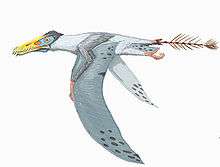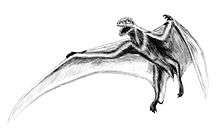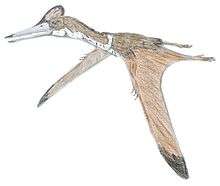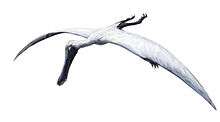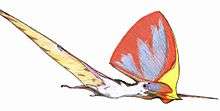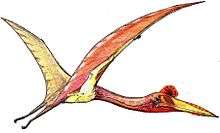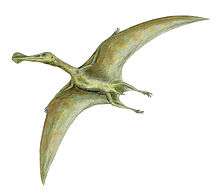Pteranodontoidea
Pteranodontoidea (or pteranodontoids, from Greek meaning "toothless wings") is an extinct clade of ornithocheiroid pterosaurs from the Early to Late Cretaceous (early Valanginian to late Maastrichtian stages) of Asia, Africa, Europe, North America and South America.[2] It was named by Alexander Wilhelm Armin Kellner in 1996. In 2003, Kellner defined the clade as a node-based taxon consisting of the last common ancestor of Anhanguera, Pteranodon and all its descendants. The clade Ornithocheiroidea is sometimes considered to be the senior synonym of Pteranodontoidea, however it depends on its definition.[3] Brian Andres (2008, 2010, 2014) in his analyses, converts Ornithocheiroidea using the definition of Kellner (2003) to avoid this synonymy.[4]
| Pteranodontoids | |
|---|---|
 | |
| Mounted skeleton of a female Geosternbergia sternbergi | |
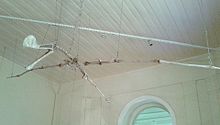 | |
| Mounted skeleton of Tropeognathus mesembrinus in the National Museum of Brazil | |
| Scientific classification | |
| Kingdom: | Animalia |
| Phylum: | Chordata |
| Order: | †Pterosauria |
| Suborder: | †Pterodactyloidea |
| Clade: | †Ornithocheiroidea |
| Clade: | †Pteranodontoidea Kellner, 1996 |
| Subgroups | |
| Synonyms | |
| |
Despite the meaning of the group's name, not all pteranodontoids were toothless, the earlier genera such as the istiodactylids and ornithocheirids had teeth that they used to catch prey, and several conclusions had led to the idea that they later evolved into the toothless pteranodontids. Pteranodontoids were also the most diverse group of pterosaurs throughout the Cretaceous period, and therefore the most successful flyers during their time.[5] They were mostly replaced by the larger azhdarchids at the end of the Late Cretaceous however, which resulted in resource and terrain competitions, but even so, pteranodontoids still managed to thrive with them, and genera such as Alcione, Barbaridactylus, Simurghia and Tethydraco lived until the Cretaceous-Paleogene extinction event (commonly known as "the extinction of the dinosaurs"), around 66 million years ago. Pteranodontoids had similar a similar diet to modern-day soaring birds such the albatross, which mainly consisted of fish. Some genera of this group however, fed mainly on carrion, this can be seen on the earlier genera such as Istiodactylus. They were also known for their proportionally large wingspans, though as mentioned earlier, not as large as those of the azhdarchids, which reached about 12 meters (39 ft), while the largest wingspan recorded of any pteranodontoid only reached 8.2 meters (27 ft).[6]
History of research
Earliest finds
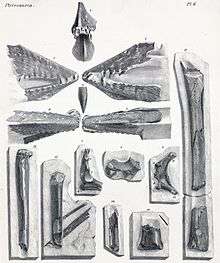
Several fossil remains were found in the Chalk Formation of England, a chalk pit known for its wide variety of fossils belonging to different animals. British paleontologist James Scott Bowerbank named and described the specimens found as a new species of Pterodactylus, P. giganteus due to its much larger size.[7] The assigning of new pterosaur species to Pterodactylus was very common at the time, since Pterodactylus was the best known pterosaur back then. In 1851, Bowerbank unearthed more specimens in the same chalk pit as P. giganteus, and assigned these specimens to yet another newly named species of Pterodactylus, known as P. cuvieri, in honor of the German naturalist and zoologist Georges Cuvier.[8] Later that year, British paleontologist Sir Richard Owen had also unearthed several fossil specimens in the Chalk Formation, in which he assigned them as Pterodactylus compressirostris during its description.[9]
Owen later unearthed many fossil specimens from a different fossil site called the Cambridge Greensand, he then assigned these specimens into a new species called Pterodactylus simus. With the naming of this new species, British paleontologist Harry Govier Seeley created a new separate genus called Ornithocheirus (from Ancient Greek "ὄρνις", meaning "bird", and "χεῖρ", meaning "hand"), due to the notion of the time, in which pterosaurs were the direct ancestors of birds. In 1869, Seeley then reassigned Pterodactylus cuvieri into a new species called Ptenodactylus cuvieri, but in 1870, Seeley had realized that the generic name Ptenodactylus had been preoccupied, and therefore he reassigned the species into Ornithocheirus cuvieri. Between these two years, Seeley had also reassigned various species of pterosaurs, including the mentioned P. cuvieri into newly named species of Ornithocheirus, therefore 27 in total. He then published a book called The Ornithosauria (meaning "bird lizard"), in reference to the relationship of birds and pterosaurs.[10][11]
Naming of early discovered genera

The naming of the different pterosaur species, as well as the genus Ornithocheirus in England resulted in further research in other places. In the United States, American paleontologist Othniel Charles Marsh led an expedition to the Smoky Hill Chalk deposits in western Kansas in 1870.[12] Marsh unearthed the first ever specimens of pterosaur from North America (specimens YPM 1160 and YPM 1161), which now belong to the genus Pteranodon, and consisted of partial wing remains and a tooth of the fish Xiphactinus, which Marsh had once believed that it belonged to Pteranodon.[13] In 1871, he assigned these specimens to a new species called "Pterodactylus oweni" (meaning "Owen's wing finger"),[14] in honor of Sir Richard Owen, but he realized that the name he had chosen had already been used for a different European pterosaur species described by Harry Seeley, so he renamed his discovery as Pterodactylus occidentalis (meaning "Western wing finger"), in reference to the location were it was found, he then used this name for its publication in 1872. In the same year, Marsh named two additional species, which were based on size differences: Pterodactylus ingens (the largest specimen found), and Pterodactylus velox (the smallest).[15] Marsh's bitter rival, American paleontologist Edward Drinker Cope had also unearthed several remains of the large North American pterosaur, and based on these remains, Cope named two new species, Ornithochirus umbrosus and Ornithochirus harpyia, in an attempt to assign them to the large European genus Ornithocheirus, but he had missed the 'e' when describing them. The paper naming these species by Cope's paper naming had been published in 1872, just five days after the publication of Marsh's paper.[15][16] This led to a dispute between the two paleontologists, which both fought over whose names had priority to the published literature, in what was obviously the same species of pterosaur.[17]
Meanwhile in England, controversies between the naming of species and genera also started, with the paleontologists Harry Seeley and Richard Owen fighting over reassignings of different species as well as genera. In 1874, Owen was not pleased with Seeley's publication of his book The Ornithosauria, and he also considered the name Ornithocheirus inappropriate.[18] Owen therefore created two new genera: Coloborhynchus (meaning "maimed beak") and Criorhynchus (meaning "ram beak"), in reference to their unique convex "keeled" crests on top, and underside of their snout. Owen then created a type species for Coloborhynchus, C. clavirostris, and sunk three species which were assigned from Ornithocheirus, and Criorhynchus consisted entirely of 5 former Ornithocheirus species, including the type species, O. simus, which was later reassigned by Owen as Criorhynchus simus.[18] In 1881 however, Seeley disagreed with Owen's conclusion, and he therefore assigned the species he named Ornithocheirus simus as the type species of Ornithocheirus. He had also named a new separate species called O. bunzeli in the same year.[19]
In 1875, Cope conceded that Marsh's names, (P. occidentalis, P. ingens and P. velox) did have priority over his, but stated that the species he named Ornithochirus umbrosus, which was formerly assigned as Pterodactylus umbrosus by Cope himself, was a distinct species, but not genus, from the ones that Marsh had previously name. Later scientists have re-evaluated and supported Marsh's case, and also found that Cope's assertion of O. umbrosus as a larger and distinct species was most likely incorrect.[20][17] In 1876, Marsh had described the first skull specimen of Pteranodon, which as unearthed by American paleontologist Samuel Wendell Williston in the Smoky Hill River, located in the Wallace County (now Logan County) of Kansas, USA. Later that year, another skull specimen was found, though this time a bit smaller in size.[21] Soon enough, Marsh recognized a major difference when he described these specimens, they lacked teeth and had bony crests on their skulls. He then described the specimens found as "distinguished from all previously known genera of the order Pterosauria by the entire absence of teeth." Marsh then coined the name Pteranodon (meaning "wing without tooth"), and pointed that the unique characteristics identified warranted a new generic name. Marsh had also reclassified all the previously named North American species from Pterodactylus to Pteranodon, and considered the smaller skull to belong to the reassigned Pteranodon occidentalis based on its size.[21][22] He also assigned the larger skull (specimen YPM 1177) to a new species which he named Pteranodon longiceps, and he later thought that this was a medium-sized species, in comparison to the larger P. ingens.[21] Specimens of smaller individuals were later uncovered, and Marsh had also named several additional species: Pteranodon comptus and Pteranodon nanus, based on these distinct and smaller fragmentary skeletons. He then created another separate species called Pteranodon gracilis, which is now based on a wing bone that he previously mistook for a pelvic bone. Marsh soon realized his mistake, and therefore reassigned that specimen he found into a separate genus which he named Nyctosaurus, and the species P. nanus was soon recognized as a Nyctosaurus specimen as well, this is due to the synapomorphies seen in both.[23] [24]

A peculiar discovery was made in 1887 by Seeley in the Isle of Wight, an island off the coast of southern England. Seeley thought that these fossil remains belonged to bird-like creature, which he then named Ornithodesmus cluniculus.[25] Later that year, British fossil collector John Whitaker Hulke suggested that Ornithodesmus was a pterosaur, therefore he found it to be similar to fossils that he had already seen before, but Seeley disagreed with him.[26] Seeley reported another specimen found on the same site, after his first discovery of the animal, it was then acquired in the British Museum in 1882. The specimen had been assigned to Ornithocheirus nobilis by Richard Lydekker in 1888, but Seeley considered it another species of Ornithodesmus, which he now considered a species of pterosaur instead of a bird. Seeley named the new species as O. latidens in 1901, the specific name translates to "wide tooth". He pressumably assigned this new species to Ornithodesmus due to synapomorphies between their sacra, but his conclusion was not entirely clear.[27][28] The type specimen, NHMUK R176, is a poorly preserved skeleton consisting of the back of the skull, a neck vertebra, a sternum, a sacrum, both right and left humeri, a notarium, part of the radius and ulna, carpals, metacarpals, as well as wing phalanx bones.[27]

American paleontologist George Fryer Sternberg uncovered several fossil remains from the lower Niobrara Formation beds in 1958, these specimens looked similar to those of P. longiceps, though the crests were set upright, and in a different position.[29] Later, in 1966, American paleontologist John Christian Harksen assigned the specimens found as a new species called Pteranodon sternbergi, due to its distinct upright crest, yet similar to that of P. longiceps.[30] This complicated the situation of Pteranodon species assigning however, which prompted another revision of the genus by Halsey W. Miller in 1971.[31] Miller concluded that all Pteranodon species except P. longiceps and P. sternbergi (the ones based on skulls) must be considered nomina dubia and abandoned because the crest shape for all of the species based on headless skeletons were impossible to determine. The conclusion of Miller however, was mostly ignored at the time, and many paleontologists kept assigning previously found specimens to new species.[32] Jeffrey Eaton had once thought that a skull he found belonged to P. ingens, but was later placed in a new species called P. marshi, and the skull he previously assigned to P. occidentalis was reassigned as P. eatoni, resulting in two new species. Contrary to his first conclusion, Miller had recognized another species based on a skull with a crest similar to that of P. sternbergi, he then assigned its specimen as a new species called P. walkeri.[32]
Revising species

The disputed controversy of Ornithocheirus was reviewed by British paleontologist Edwin Tulley Newton in 1888, in which he reassigned 13 existing species into Ornithocheirus, interestingly, he also reassigned Cope's Ornithochirus umbrosus and Ornithochirus harpyia into Ornithocheirus, now with the correct spelling (which includes the 'e' that Cope missed).[33]
Meanwhile in the USA, Samuel Williston examined the classification of Pteranodon by Marsh in 1892, and he noticed that back in 1871, a mention by Seeley about a partial set of toothless pterosaur jaws from the Cambridge Greensand of England had taken place, which he then named his discovery as "Ornithostoma". Williston also noted that the primary characteristic Marsh had used to separate Pteranodon from other pterosaurs was its lack of teeth, and because "Ornithostoma" was toothless, this made Williston conclude that "Ornithostoma" must be considered the senior synonym of Pteranodon.[34] German paleontologist Felix Plieninger in 1901 however, pointed out that "Ornithostoma" had never been scientifically described or even assigned to a species name until Williston's conclusion, and therefore had been considered a nomen nudum, which in this case could not beat out Pteranodon for naming priority.[35] Williston accepted his conclusion, and went back to calling the genus Pteranodon, but both Williston and Plieninger however, were incorrect, because unnoticed by both of them was the fact that in 1891, Seeley himself had finally described and properly named Ornithostoma, assigning it to a new species called O. sedgwicki.[36] Much later in the 2010s, more research on the identity of Ornithostoma had shown that it was not Pteranodon or even a close relative, but may in fact have been an azhdarchoid pterosaur similar to Quetzalcoatlus, which are also toothless pterosaurs.[37][17] Later in 1892, Williston had become the first scientist to critically evaluate all of the Pteranodon species classified by Cope and Marsh. He agreed with most of Marsh's reassignings and classifications, but several exceptions were still made.[23] He did not believe that P. ingens and O. umbrosus could be considered synonyms, which even Cope had come to believe, and he also considered both P. velox and P. longiceps to be dubious. Williston's reason was that P. velox was mainly based on non-diagnostic fragments, and P. longiceps was probably a synonym of one of the other previously named species.[34] Williston revised his earlier conclusion in 1903, in which he stated that there were only three species of Pteranodon, instead of seven. He also considered both P. comptus and P. nanus to be specimens of Nyctosaurus, and divided the other species into small (P. velox), medium (P. occidentalis), and large species (P. ingens), based primarily on the shape of their upper arm bones. He also followed his first conclusion of P. longiceps being a synonym of either P. velox or P. occidentalis based on its size.[38] Later that year, paleontologist Jeffrey G. Eaton became the first scientist to publish a more detailed description of the entire skeleton of Pteranodon. He used most of his findings to revise its classification, once again based on a better understanding of the differences in pteranodontian anatomy.[17] Experiments using clay models of bones was conducted by Eaton to help determine the effects of crushing and flattening of the shapes of the arm bones that Williston had used in his own classifications.[38] Eaton concluded that most of the differences in bone shapes could be easily explained by the pressures of fossilization, and concluded that none of the skeletons of Pteranodon had any significant differences from each other besides their size. Therefore, Eaton was left to decide his classification scheme only based on skull differences, in which he assigned them to three different species according to their size. He only recognized three valid species in the end of his description: P. occidentalis, P. ingens, and P. longiceps.[39][40]
_(14784356062).jpg)
In 1913, the British amateur paleontologist Reginald Walter Hooley described two more specimens found that belonged to O. latidens, which were collected in 1904 from the sea after a rockfall near Atherfield Point on the Isle of Wight. Specimen NHMUK R3877 was the first to be collected, and consisted of a skull, neck and trunk vertebrae, a shoulder blade, an ischium, and parts of the forelimbs. Specimen NHMUK R3878, was the second to be collected, and includes parts of the pectoral girdle as well as forelimbs. These specimens found represent the most complete remains of Cretaceous pterosaurs in England, more complete than even Ornithocheirus, and specimen NHMUK R3877 was one of the only known three-dimensionally preserved pterosaur skeletons during the 20th century. Hooley also reviewed O. latidens in detail, and placed the genus Ornithodesmus in its own family, Ornithodesmidae.[41][42] Williston from the USA, subsequently reviewed Hooley's article, disagreeing with some of his conclusions about the anatomy and classification of the animal.[43] After the monograph of Hooley about Ornithodesmus, little was written about the animal for the rest of the century, and similar pterosaurs were nowhere to be found for decades.[44] Later in 1993, the British paleontologists Stafford C. Howse and Andrew C. Milner concluded that the holotype sacrum and only specimen of the species O. cluniculus didn't belong to a pterosaur, but instead to a maniraptoran theropod dinosaur. They pointed out that no detailed attempts had been made to compare the sacrum of O. cluniculus with those of pterosaurs, and that the species O. latidens had in effect been treated as the type species of the genus Ornithodesmus in their conclusion. Now as a definite species of pterosaur, "O." latidens thus required a new generic name.[45] In 2001, Howse, Milner, and David Martill, reassigned "O." latidens to a new genus called Istiodactylus, resulting in a new combination known as I. latidens. The generic name Istiodactylus means "sail finger", in reference to its proportionally large wings. Howse, Milner, and David Martill had also named a new family called Istiodactylidae after moving "O." latidens into Istiodactylus, with Istiodactylus as the only member of the family.[42]
In 1914, Hooley had made a brief review of the pterosaur Ornithocheirus, he kept its generic name, but created two new genera: Lonchodectes (meaning "lance biter"), and Amblydectes (meaning "blunt biter"), in reference to the shape of their snouts.[46] Many paleontologists weren't aware of this reassigning however, and therefore it wasn't used much at the time.[47] The species Pterodactylus compressirostris, uncovered by Owen back in 1851, was formerly transferred to Ornithocheirus in 1870 by Seeley, but it became the type species of Lonchodectes in Hooley's review.[11] This species however, was confusingly regarded, incorrectly, as the type species of Ornithocheirus. Hooley reassigned the species O. crassidens as the type species of Amblydectes, but fossil remains are scarce, so little of the animal is known.[47]
Classification
Originally defined by Alexander Kellner in 1996, Pteranodontoidea is sometimes considered a synonym of the clade Ornithocheiroidea according to several studies. The name Ornithocheiroidea was originally defined as an apomorphy-based taxon by Christopher Bennett in 1994. In 2003 however, Kellner redefined Ornithocheiroidea to represent the node of Anhanguera, Pteranodon, Quetzalcoatlus and Dsungaripterus, thus making Ornithocheiroidea a more inclusive group.[48] Later that year, David Unwin suggested a different definition, the node that contains Pteranodon longiceps and Istiodactylus latidens, as a resulting, he considered Pteranodontoidea a junior synonym of Ornithocheiroidea.[3] Brian Andres (2008, 2010, 2014) in his analyses, converts Ornithocheiroidea using the definition of Kellner (2003) to avoid this synonymy.[4] Andres & Myers (2013) presented a phylogenetic analysis that placed Pteranodontoidea within the group Pteranodontia, as the sister taxon of the family Nyctosauridae. In 2018 however, Longrich, Martill, and Andres revisited the classification, and concluded that Pteranodontoidea would be the more inclusive group containing both Ornithocheiromorpha and Pteranodontia.[49][50]
|
Topology B: Longrich, Martill, and Andres (2018).[50]
|
Paleobiology
Locomotion
Pteranodontoids, like other pterosaurs, are considered to have been skilled fliers as well as adept at moving on the ground. Evidence from footprints shows that most pterosaurs did not sprawl their limbs to a large degree, as in modern reptiles, but rather held the limbs relatively erect when walking, like dinosaurs. While no pteranodontoid footprints are known, it is likely that they also walked erect.[51] Among pterosaurs, pteranodontoids had unusually uneven limb proportions, with the forelimbs much longer than the hind limbs. This would likely have required them to use unique modes of locomotion when on the ground compared to other pterosaurs. It is possible that pteranodontoids ran (but not walked) bipedally, or that they used a hopping gait.[51] Pterosaur researcher Mike Habib has noted that the limbs proportions of pteranodontoids like Anhanguera are consistent with hopping.[52]
References
- Federico L. Agnolin and David Varricchio (2012). "Systematic reinterpretation of Piksi barbarulna Varricchio, 2002 from the Two Medicine Formation (Upper Cretaceous) of Western USA (Montana) as a pterosaur rather than a bird" (PDF). Geodiversitas. 34 (4): 883–894. doi:10.5252/g2012n4a10.
- Richard J. Butler, Stephen L. Brusatte, Brian B. Andres and Roger B. J. Benson (2012). "How do geological sampling biases affect studies of morphological evolution in deep time? A case study of the Pterosauria (Reptilia: Archosauria)". Evolution. 66 (1): 147–162. doi:10.1111/j.1558-5646.2011.01415.x. PMID 22220871.CS1 maint: multiple names: authors list (link)
- Unwin, D. M., (2003): On the phylogeny and evolutionary history of pterosaurs. pp. 139-190. — in Buffetaut, E. & Mazin, J.-M., (eds.): Evolution and Palaeobiology of Pterosaurs. Geological Society of London, Special Publications 217, London, 1-347
- Andres, Brian Blake (2014). Systematics of the Pterosauria. Yale University. p. 366. A preview that shows the cladogram without clade names
- Federico L. Agnolin & David Varricchio (2012). "Systematic reinterpretation of Piksi barbarulna Varricchio, 2002 from the Two Medicine Formation (Upper Cretaceous) of Western USA (Montana) as a pterosaur rather than a bird" (PDF). Geodiversitas. 34 (4): 883–894. doi:10.5252/g2012n4a10.
- Kellner, A. W. A.; Campos, D. A.; Sayão, J. M.; Saraiva, A. N. A. F.; Rodrigues, T.; Oliveira, G.; Cruz, L. A.; Costa, F. R.; Silva, H. P.; Ferreira, J. S. (2013). "The largest flying reptile from Gondwana: A new specimen of Tropeognathus cf. T. Mesembrinus Wellnhofer, 1987 (Pterodactyloidea, Anhangueridae) and other large pterosaurs from the Romualdo Formation, Lower Cretaceous, Brazil". Anais da Academia Brasileira de Ciências. 85: 113. doi:10.1590/S0001-37652013000100009.
- Bowerbank, J.S. (1846). "On a new species of pterodactyl found in the Upper Chalk of Kent (Pterodactylus giganteus)". Quarterly Journal of the Geological Society of London. 2 (1–2): 7–9. doi:10.1144/gsl.jgs.1846.002.01-02.05.
- Bowerbank, J.S. (1851). "On the pterodactyles of the Chalk Formation". Proceedings of the Zoological Society of London. 19: 14–20. doi:10.1111/j.1096-3642.1851.tb01125.x.
- Owen, R. (1851). Monograph on the fossil Reptilia of the Cretaceous Formations. The Palaeontographical Society 5(11):1-118.
- Seeley, H.G., 1869, Index to the fossil remains of Aves, Ornithosauria, and Reptilia, from the Secondary System of Strata, arranged in the Woodwardian Museum of the University of Cambridge. St. John's College, Cambridge 8: 143. doi:10.1080/00222937008696143
- Seeley, H.G. (1870). The Ornithosauria: an Elementary Study of the Bones of Pterodactyles. Cambridge, 130 pp.
- Betts, C. W. 1871. The Yale College Expedition of 1870. Harper’s New Monthly Magazine, 43(257):663–671
- Marsh, O. C. 1871. Scientific expedition to the Rocky Mountains. American Journal of Science, ser. 3, 1(6):142–143.
- Marsh, O. C., 1871.
"Note on a new and gigantic species of Pterodactyle."
American Journal of Science, ser. 3, 1(6):472 oceansofkansas
.com /Marsh71 .htm - Marsh, O. C. 1872. Discovery of additional remains of Pterosauria, with descriptions of two new species. American Journal of Science, Series 3, 3(16):241–248.
- Cope, E. D. (1872). "On two new Ornithosaurians from Kansas". Proceedings of the American Philosophical Society. 12 (88): 420–422.
- Bennett, S.C. (1994). "Taxonomy and systematics of the Late Cretaceous pterosaur Pteranodon (Pterosauria, Pterodactyloida)". Occasional Papers of the Natural History Museum, University of Kansas. 169: 1–70.
- Owen, R. 1874, Monograph on the fossil Reptilia of the Mesozoic Formations. Palaeontographical Society, London, 14 pp
- Seeley, H. G. (1881). "The Reptile Fauna of the Gosau Formation preserved in the Geological Museum of the University of Vienna". Quarterly Journal of the Geological Society. 37 (1): 620–706. doi:10.1144/GSL.JGS.1881.037.01-04.49.
- Cope, E.D. (1875). "The Vertebrata of the Cretaceous formations of the West." Report, U. S. Geological Survey of the Territories (Hayden), 2: 302 pp., 57 pls.
- Marsh, O.C. (1876a). "Notice of a new sub-order of Pterosauria". American Journal of Science. Series 3. 11 (65): 507–509. doi:10.2475/ajs.s3-11.66.507.
- Bennett, S.C. (2000). "Inferring stratigraphic position of fossil vertebrates from the Niobrara Chalk of western Kansas." Current Research in Earth Sciences: Kansas Geological Survey Bulletin, 244(Part 1): 26 pp.
- Marsh, O.C. (1876b). "Principal characters of American pterodactyls". American Journal of Science. Series 3. 12 (72): 479–480. doi:10.2475/ajs.s3-12.72.479.
- Witton, M. (2010). Pteranodon and beyond: The history of giant pterosaurs from 1870 onwards. Geological Society of London Special Publications. 343. 313-323. doi:10.1144/SP343.19
- Seeley, H. G. (1887). "On a sacrum apparently indicating a new type of bird, Ornithodesmus cluniculus Seeley from the Wealden of Brook". Quarterly Journal of the Geological Society of London. 43 (1–4): 206–211. doi:10.1144/GSL.JGS.1887.043.01-04.19.
- Seeley, H. G. (1887). "On Patricosaurus merocratus, Seeley, a lizard from the Cambridge Greensand, preserved in the Woodwardian Museum of the University of Cambridge". Quarterly Journal of the Geological Society of London. 43 (1–4): 219–220. doi:10.1144/gsl.jgs.1887.043.01-04.21.
- Seeley, H. G. (2015) [1901]. Dragons of the Air: an Account of Extinct Flying Reptiles. New York: D. Appleton & Co. pp. 173–175. ISBN 978-1440084942.
- Howse, S. C. B.; Milner, A. R. (1993). "Ornithodesmus – a maniraptoran theropod dinosaur from the Lower Cretaceous of the Isle of Wight, England". Palaeontology. 36: 425–437.
- Sternberg, G. F.; Walker, M. V. (1958). "Observation of articulated limb bones of a recently discovered Pteranodon in the Niobrara Cretaceous of Kansas". Transactions of the Kansas Academy of Science. 61 (1): 81–85. doi:10.2307/3626742. JSTOR 3626742.
- Harksen, J. C. (1966). "Pteranodon sternbergi, a new fossil pterodactyl from the Niobrara Cretaceous of Kansas". Proceedings South Dakota Academy of Science. 45: 74–77.
- Miller, H. W. (1971). "The taxonomy of the Pteranodon species from Kansas". Transactions of the Kansas Academy of Science. 74 (1): 1–19. doi:10.2307/3627663. JSTOR 3627663.
- Bennett, S.C. (1994). "The Pterosaurs of the Niobrara Chalk". The Earth Scientist. 11 (1): 22–25.
- Newton, E. T., 1888, "On the Skull, Brain, and Auditory Organ of a new species of Pterosaurian (Scaphognathus purdoni), from the Upper Lias near Whitby, Yorkshire", Philosophical Transactions of the Royal Society of London, v. 179, p. 503-537
- Williston, S.W., 1892, "Kansas pterodactyls, Part II", Kansas University Quarterly, 2: 97-81
- Plieninger F., 1901. Beiträge zur kenntnis der Flugsaurier. Palaeontolographica, 53, 209-213.
- Seeley, H.G., 1891, "On the shoulder girdle in Cretaceous Ornithosauria", Annals and Magazine of Natural History Series 6 7: 237-255
- Averianov, A.O. (2012). "Ornithostoma sedgwicki – valid taxon of azhdarchoid pterosaurs". Proceedings of the Zoological Institute RAS. 316 (1): 40–49.
- Williston, S. W. 1903. On the osteology of Nyctosaurus (Nyctodactylus), with notes on American pterosaurs. Field Mus. Publ. (Geological Ser.) 2(3):125–163, 2 figs., pls. XL-XLIV.
- Eaton, G. F. 1903. The characters of Pteranodon. American Journal of Science, ser. 4, 16(91):82–86, pl. 6-7.
- Eaton, G. F., 1904. The characters of Pteranodon (second paper). American Journal of Science, ser. 4, 17(100):318–320, pl. 19-20.
- Hooley, R. W. (1913). "On the skeleton of Ornithodesmus latidens; an ornithosaur from the Wealden Shales of Atherfield (Isle of Wight)". Quarterly Journal of the Geological Society. 69 (1–4): 372–422. doi:10.1144/GSL.JGS.1913.069.01-04.23.
- Howse, S. C. B.; Milner, A. R.; Martill, D. M. (2001). "Pterosaurs". In Martill, D. M.; Naish, D. (eds.). Dinosaurs of the Isle of Wight. Guide 10; Field Guides to Fossils. London: The Palaeontological Association. pp. 324–335. ISBN 978-0-901702-72-2.
- Wllliston, S. W. (1913). "Reviews: the skeleton of Ornithodesmus latidens". The Journal of Geology. 21 (8): 754–756. Bibcode:1913JG.....21..754W. doi:10.1086/622124. JSTOR 30058408.
- Witton, Mark (2013). Pterosaurs: Natural History, Evolution, Anatomy. Princeton University Press. pp. 31–44. ISBN 978-0691150611.
- Howse, S. C. B.; Milner, A. R. (1993). "Ornithodesmus – a maniraptoran theropod dinosaur from the Lower Cretaceous of the Isle of Wight, England". Palaeontology. 36: 425–437.
- Unwin, D.M. (2006). The Pterosaurs: From Deep Time. Pi Press:New York, p. 251. ISBN 0-13-146308-X.
- Hooley, R.W. (1914). On the Ornithosaurian genus Ornithocheirus with a review of the specimens from the Cambridge Greensand in the Sedgwick Museum, Cambridge. Annals and Magazine of Natural History, series 8, 78: 529-557.
- Kellner, A. W. A., (2003): Pterosaur phylogeny and comments on the evolutionary history of the group. pp. 105-137. — in Buffetaut, E. & Mazin, J.-M., (eds.): Evolution and Palaeobiology of Pterosaurs. Geological Society of London, Special Publications 217, London, 1-347
- Andres, B.; Myers, T. S. (2013). "Lone Star Pterosaurs". Earth and Environmental Science Transactions of the Royal Society of Edinburgh. 103 (3–4): 383–398. doi:10.1017/S1755691013000303.
- Longrich, N.R., Martill, D.M., and Andres, B. (2018). Late Maastrichtian pterosaurs from North Africa and mass extinction of Pterosauria at the Cretaceous-Paleogene boundary. PLoS Biology, 16(3): e2001663. doi:10.1371/journal.pbio.2001663
- Witton, M.P.; Habib, M.B. (2010). "On the Size and Flight Diversity of Giant Pterosaurs, the Use of Birds as Pterosaur Analogues and Comments on Pterosaur Flightlessness". PLoS ONE. 5 (11): e13982. doi:10.1371/journal.pone.0013982. PMC 2981443. PMID 21085624.
- Habib, M. (2011). "Dinosaur Revolution: Anhanguera." H2VP: Paleobiomechanics. Weblog entry, 20-SEP-2011. Accessed 28-SEP-2011: http://h2vp.blogspot.com/2011/09/dinosaur-revolution-anhanguera.html

